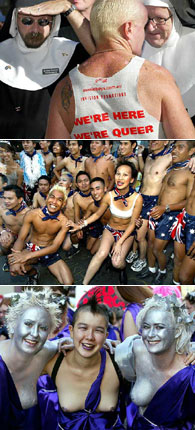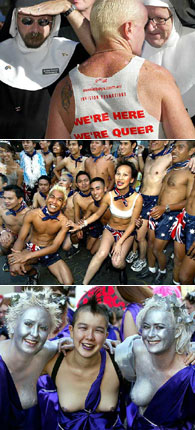The Sydney Gay and Lesbian Mardi Gras over the weekend was dubbed a success despite attracting an estimated at 250 000 participants, marchers and spectators lining the streets - half of the usual turnout in previous years.

After unsuccessful attempts by several individuals to try to keep the festival afloat, the 25-year-old festival was eventually saved by four Sydney-based gay and lesbian community groups - AIDS Council of NSW (ACON), the Sydney Pride Centre, the Gay and Lesbian Rights Lobby and Queer Screen - who paid off the debt-ridden event's key assets and took over the running of the entire festival.
Organisers were pleased with how the celebrations turned out. Stevie Clayton, co-chairwoman of New Mardi Gras, the organisation that replaced the previous body announced that this year's revived and more modest event is likely to enjoy a surplus of more than A$350,000, some A$300,000 more than its original forecast just of A$50,000.
She attributed the success of the event to renewed "heart connection", or community support, as seen by the sale of 17,000 tickets to the post-parade party at Fox Studios. The less extravagant celebrations this year reflected a return to a less overtly commercial, more community-based ethos, than in previous years.
The parade was used scaled down compared to previous years, there were fewer elaborate and outrageous floats - 140 compared with 200 last year - due to the shorter lead-time to the event.
Organisers were however heartened by the turnout.
"Tonight we have seen the resurgence of Mardi Gras as the icon of Sydney," New Mardi Gras co-chair Michael Woodhouse told reporters.
"It has proved that this is an institution that continues to be relevant and important not just to the gay, lesbian, bisexual and transgender communities but to the rest of Sydney, to this nation and to the world."
This year also saw a break in tradition with Roadrunners, a gay men's motorcycle club, who rode with the renowned Dykes on Bikes motorcade for the first time, nearly fifteen years after their lesbian counterparts first joined the annual procession.

Marchers supporting the highly political Gay and Lesbian Rights Lobby sported T-shirts emblazoned with the slogan: "We're here, we're queer and we vote."
The group was campaigning for the age of consent for gay males to be lowered from 18 to 16, along with demands for laws enabling same-sex couples to access in-vitro fertilisation treatments and adoption.
For the first time since 1993, this year's parade has not and will not be televised, as organisers could not sew up a deal due to time constraints.
Last year, the Ten Network showed a delayed telecast four days after the parade, and ratings were disappointing. The parade was also shown live on pay-TV on a pay-per-view basis. According to news.com.au, Network Ten said it could not come to terms that made commercial sense for 2003.
Although it might take a few months to complete, organisers have commissioned a one-hour made-for-television documentary called Continuing The Dream and expects network interest.
Co-chair Woodhouse said the documentary would allow for more of a significant story to come out of the parade, and give parade organisers more control.











 打印版本
打印版本










读者回应
抢先发表第一个回应吧!
请先登入再使用此功能。